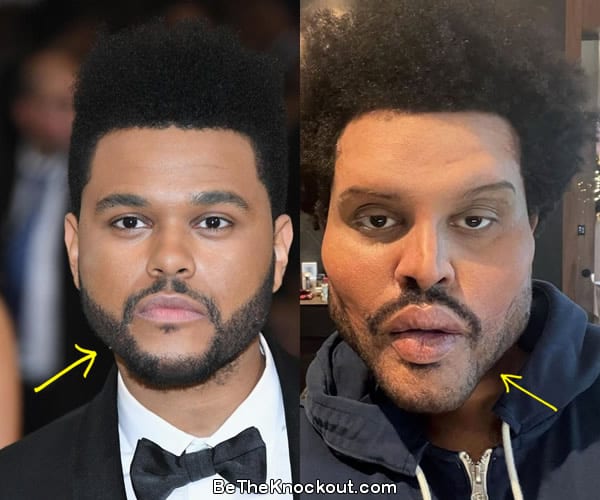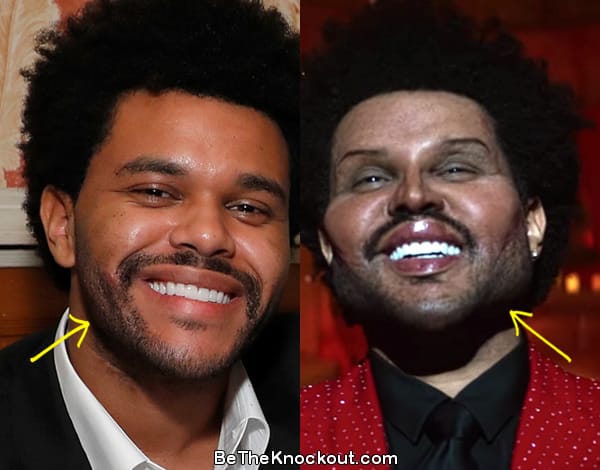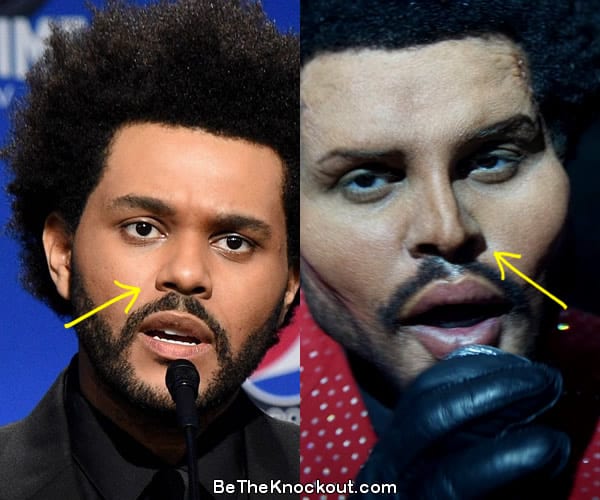The Weeknd Plastic Surgery Rumors: Unpacking Abel Tesfaye's Artistic Transformation
The buzz around Abel Tesfaye, widely known as The Weeknd, and his changing appearance has certainly sparked many conversations. People everywhere, it seems, have been wondering about what exactly was going on with his face. Was it plastic surgery? Was it something else entirely? This question, very much, got folks talking, especially when he showed up with what looked like bandages or even a distorted face in public and in his music videos. It’s a topic that really captured a lot of attention, and for good reason, too it's almost as if the mystery was part of the fun.
For a musician who first gained recognition in 2009 after releasing music anonymously, sparking international acclaim, a sudden shift in public appearance can feel quite jarring. Abel Makkonen Tesfaye, professionally known as The Weeknd, is a Canadian singer born February 16, 1990, in Toronto, Ontario, to Ethiopian parents. His music, often related through morose alternative R&B ballads, already explores emotionally and physically toxic indulgences, so a visual transformation, you know, just adds another layer to his art.
This article aims to clear up some of the curiosity surrounding The Weeknd's appearance, looking at the story behind those striking visual changes. We will explore the artistic reasons for his transformation, connecting it back to his unique storytelling style and the themes that run through his incredibly popular music. So, perhaps, let's just consider what his choices mean for his artistry and how they fit into the bigger picture of his career.
Table of Contents
- Abel Tesfaye: The Artist Behind The Weeknd
- Biography and Personal Details
- The Weeknd's Visual Storytelling: A Deep Dive into the After Hours Era
- The Face Bandages and Prosthetics: Unveiling the Artistic Intent
- Why the Shocking Look? Exploring the Narrative
- Beyond the After Hours Character: The Weeknd's Evolving Artistry
- The Impact of Visuals on Musical Narrative
- Frequently Asked Questions About The Weeknd's Appearance
- Final Thoughts on Abel Tesfaye's Artistic Expression
Abel Tesfaye: The Artist Behind The Weeknd
Abel Makkonen Tesfaye, known globally as The Weeknd, has built a career on pushing boundaries, both musically and visually. Born on February 16, 1990, in Toronto, Ontario, to Ethiopian parents, his journey to superstardom is a rather interesting one. He first gained recognition in 2009 after releasing music anonymously, and that, in a way, sparked international acclaim. His early work, uploaded to YouTube in late 2010, gave listeners a taste of his distinct sound, which quickly gathered a following.
The Weeknd is the alias of Abel Tesfaye, an enigma turned superstar whose accounts of emotionally and physically toxic indulgences are related through morose alternative R&B ballads. As much as a part of me wants to knock this album for it sounding so The Weeknd, I can't because it's a consistently solid album, no bad tracks, a few that really are hard to turn off. His sound is, you know, quite distinctive, blending dark themes with smooth, often melancholic melodies. This combination has allowed him to create a truly unique space in the music world, making him a household name.
Biography and Personal Details
To better understand the artist and his choices, it helps to look at some key details about Abel Tesfaye himself. This information, actually, gives us a bit of context for his artistic journey and the character he often portrays.
| Full Name | Abel Makkonen Tesfaye |
| Stage Name | The Weeknd |
| Born | February 16, 1990 |
| Birthplace | Toronto, Ontario, Canada |
| Parents' Origin | Ethiopian |
| Profession | Singer, Songwriter, Record Producer, Actor |
| First Gained Recognition | 2009 (anonymous music releases) |
| Known For | Alternative R&B ballads, distinctive vocal style, visual artistry |
The Weeknd's Visual Storytelling: A Deep Dive into the After Hours Era
The conversation about "The Weeknd plastic surgery" really picked up during his "After Hours" album cycle, which began around 2020. This period saw Abel Tesfaye adopt a very specific character, one that evolved visually throughout music videos, live performances, and public appearances. It was a character, arguably, that showed the darker side of Hollywood and excess, and his face became a central part of this narrative. This artistic choice, honestly, got many people quite curious.
The "After Hours" character started out looking relatively normal, but as the story unfolded across videos like "Heartless," "Blinding Lights," and "Too Late," his appearance began to change quite dramatically. First, he appeared with a bloodied nose and face, suggesting a night of wild abandon and perhaps, just a little bit, a consequence of his indulgent lifestyle. Then came the bandages, covering his entire face, which really made people wonder what was underneath. This progression was, in a way, a visual representation of the album's themes.
The culmination of this visual narrative arrived when he appeared with what looked like extreme plastic surgery, a distorted, almost grotesque version of his face. This was seen in the music video for "Save Your Tears" and during his Super Bowl LV halftime show performance. This look, naturally, sparked widespread discussion and led many to ask if The Weeknd had actually undergone cosmetic procedures. It was a powerful statement, to be honest, and it certainly got people talking.
The Face Bandages and Prosthetics: Unveiling the Artistic Intent
So, was it really plastic surgery? The simple answer is no. The dramatic changes to The Weeknd's face were not the result of actual cosmetic procedures. Instead, they were the work of incredibly skilled makeup artists and prosthetics designers. The bandages, for example, were part of the initial phase of his character's transformation, hinting at injuries or perhaps, just a little bit, a recovery from some sort of ordeal. This visual element, you know, added to the mystery surrounding the character.
Later, the highly realistic "distorted" face was created using prosthetics, which are special effects pieces applied to the skin to alter one's appearance. These prosthetics, very much, gave the illusion of botched cosmetic surgery, complete with exaggerated cheekbones, swollen lips, and an unnatural smoothness. It was a visual trick, basically, designed to serve the story he was telling. This commitment to the character, even in public, showed his dedication to his art.
Starring Abel Tesfaye, Jenna Ortega, and Barry Keoghan in various projects, it is clear that Tesfaye embraces the world of acting and character portrayal. The "After Hours" character was, in essence, a role he played, a hallucinatory exploration of the human psyche, as some might describe his broader artistic themes. The visual transformation was a key part of bringing this particular character to life, showing the extremes of a life consumed by superficiality and excess. It was, quite literally, a face for his narrative.
Why the Shocking Look? Exploring the Narrative
The decision to portray a character with such a jarring appearance was deeply rooted in the themes of the "After Hours" album. The album explores the dark side of Hollywood, the emptiness of fame, and the consequences of a hedonistic lifestyle. The character's physical deterioration, culminating in the "plastic surgery" look, was a metaphor for the internal decay that can come with such a life. It was, in some respects, a commentary on superficiality and the pressures to conform to unrealistic beauty standards in the entertainment industry.
This visual narrative also served as a critique of celebrity culture itself, where appearances can often be deceiving. By presenting a distorted version of himself, The Weeknd was, perhaps, challenging viewers to look beyond the surface and consider the deeper message. It was a bold move, honestly, and it certainly made a lasting impression. The character's journey from a seemingly carefree partygoer to a disfigured, almost tragic figure, was a powerful visual arc that complemented the album's sound.
Moreover, the entire "After Hours" era was designed to be a cohesive artistic experience, where the visuals, the music, and the live performances all worked together to tell a single, overarching story. The "plastic surgery" look was just one piece of this elaborate puzzle. It was a way to make the audience feel the discomfort and the unease that the character was experiencing, drawing them deeper into his world. This level of commitment to storytelling is, you know, pretty rare in popular music.
Beyond the After Hours Character: The Weeknd's Evolving Artistry
While the "After Hours" character and his visual transformation were a significant chapter, Abel Tesfaye's artistry extends far beyond that single narrative. He is a Canadian recording artist and record producer who has consistently pushed the boundaries of R&B, incorporating elements of pop, soul, and hip-hop. His music often delves into themes of isolation, heartbreak, and identity, which, in a way, resonate with a wide audience. He is, simply put, a master of mood.
The Weeknd is the alias of Abel Tesfaye, an enigma turned superstar whose accounts of emotionally and physically toxic indulgences are related through morose alternative R&B ballads. As much as a part of me wants to knock this album for it sounding so The Weeknd, I can't because it's a consistently solid album, no bad tracks, a few that really are hard to turn off. His ability to craft compelling narratives, both lyrically and visually, is a hallmark of his career. He uses his platform to explore complex human experiences, making his art feel very, very real.
His work, from his early anonymous releases to his current global hits, shows a consistent commitment to artistic expression. He's not afraid to experiment, to challenge perceptions, and to use his art as a mirror to society. The "plastic surgery" illusion was just one example of his willingness to go to great lengths to tell a story and provoke thought. It was, arguably, a very clever way to engage his audience on multiple levels.
The Impact of Visuals on Musical Narrative
The Weeknd's use of visual transformation highlights the powerful connection between music and imagery in contemporary art. For an artist like Abel Tesfaye, whose music often paints vivid pictures of emotional and physical indulgence, the visual component becomes a crucial extension of the narrative. It allows him to create a fully immersive world for his listeners, making the themes of his songs even more impactful. This is, basically, how he draws you in.
The "After Hours" character, with his evolving appearance, provided a tangible representation of the album's dark journey. It showed, rather than just told, the story of someone losing themselves in the excesses of fame and superficiality. This kind of visual storytelling, you know, can leave a much deeper impression than music alone. It turns an album into a cinematic experience, where every detail, from the sound to the look, serves a purpose.
Artists often use visual elements to enhance their message, but The Weeknd took it to an extreme, blurring the lines between reality and performance. His commitment to staying in character, even during high-profile events like the Super Bowl, reinforced the artistic statement he was making. It was a bold artistic choice, truly, and it solidified his reputation as an artist who is not afraid to challenge conventions and push creative boundaries. You can learn more about The Weeknd's artistic journey on our site, and link to this page for more insights into celebrity transformations.
Frequently Asked Questions About The Weeknd's Appearance
Did The Weeknd actually get plastic surgery?
No, The Weeknd did not actually undergo plastic surgery. His dramatically altered appearance during the "After Hours" era was the result of elaborate special effects makeup and prosthetics. This was, in a way, part of a character he was portraying for his album's narrative and music videos.
Why did The Weeknd appear with bandages on his face?
The bandages on The Weeknd's face were part of the evolving visual story for his "After Hours" character. They symbolized the character's journey through excess and injury, hinting at a recovery or perhaps, just a little bit, a consequence of his wild lifestyle. It was a visual element designed to deepen the album's themes.
What was the meaning behind The Weeknd's distorted face in the "Save Your Tears" video?
The distorted face, achieved with prosthetics, represented the extreme consequences of superficiality and the emptiness of Hollywood culture, which are central themes of the "After Hours" album. It was a visual metaphor for the character's internal decay and the artificiality that can come with fame. It was, very much, a statement on the pressures of image.
Final Thoughts on Abel Tesfaye's Artistic Expression
The discussion around "The Weeknd plastic surgery" ultimately points to the power of artistic expression and storytelling. Abel Tesfaye, through his alias The Weeknd, consistently creates immersive worlds that extend beyond just sound. His willingness to use visual transformations, even those that spark widespread speculation, shows a deep commitment to his craft. He uses every tool at his disposal to tell his stories, whether it's through his morose alternative R&B ballads or his striking visual performances.
This approach invites listeners and viewers to engage with his art on a deeper level, to look beyond the surface and consider the messages embedded within. It is a testament to his artistry that he can provoke such strong reactions and conversations, all while staying true to his unique vision. For anyone interested in the intersection of music, performance, and narrative, The Weeknd's work offers a truly fascinating case study. You can explore his official website for more insights into his creative universe: The Weeknd Official Website.

The Weeknd Plastic Surgery Comparison Photos

The Weeknd Plastic Surgery Comparison Photos

The Weeknd Plastic Surgery Comparison Photos